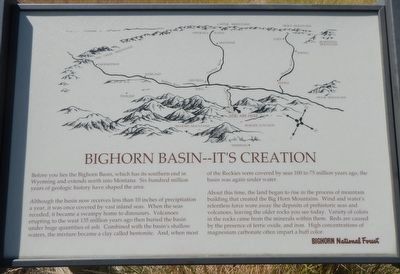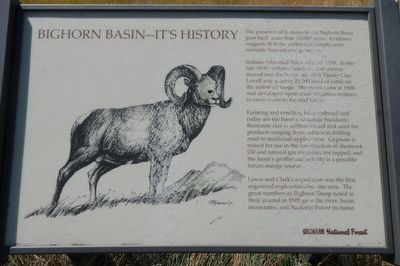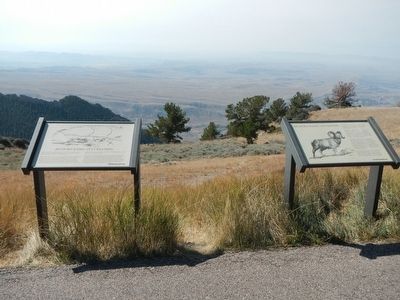Near Lovell in Big Horn County, Wyoming — The American West (Mountains)
Bighorn Basin
It's Creation
— It's History —
Before you lies the Bighorn Basin, which has its southern end in Wyoming and extends into Montana. Six hundred million years of geologic history have shaped the area.
Although the basin now receives less than 10 inches of precipitation a year, it was once covered by vast inland seas. When the seas receded, it became a swampy home to dinosaurs. Volcanoes erupted to the west 135 million years ago then buried the basin under huge quantities of ash. Combined with the basins's shallow waters, the mixture became a clay called bentonite. And, when most of Rockies were covered by seas 100 to 75 million years ago, the basin was again under water.
About this time, the land began to rise in the process of mountain building that created the Big Horn Mountains. Wind and water's relentless force wore away the deposits of prehistoric seas and volcanoes, leaving the older rocks you see today. Variety of colors in the rocks came from the mineral within them. Reds are caused by the presence of ferric oxide, and iron. High concentrations of magnesium carbonate often impart a buff color.
The presence of humans in the Bighorn Basin goes back more than 10,00 years. Evidence suggests that the prehistoric people were nomadic hunters and gatherers.
Indians inhabited this area until 1878. In the late 1870s settlers, ranchers and miners moved into the basin. By 1883, Henry Clay Lovell was grazing 25,000 head of cattle on the unfenced range. Mormons came in 1900 and developed open canal irrigation systems to carry water to the arid lands.
Farming and ranching have endured and today are the basin's economic backbone. Bentonite clay is surface-mined and used for products ranging from industrial drilling mud to medicinal applications. Gypsum is mined for use in the construction of sheetrock. Oil and natural gas resources are tapped and the basin's geothermal activity is a possible future energy source.
Lewis and Clark's expedition was the first organized exploration into the area. The great numbers of Bighorn Sheep noted in their journal in 1808 (sic) gave the river, basin, mountains, and National Forest it's name.
Erected by U.S. Department of Agriculture, Bighorn National Forrest.
Topics. This historical marker is listed in this topic list: Natural Features.
Location. 44° 47.356′ N, 107° 55.852′ W. Marker is near Lovell, Wyoming, in Big Horn County. Marker can be reached from U.S. 14A at milepost 74 near 651, on the left when traveling east. Touch for map. Marker is in this post office area: Lovell WY 82431, United States of America. Touch for directions.
Other nearby markers. At least 8 other markers are within 5 miles of this marker, measured as the crow flies. Big Horn Basin (within shouting distance of this marker); Reconstruction - Finally! (approx. 1.9 miles away); Five Springs (approx. 2½ miles away); Welcome to the Medicine Wheel (approx. 2.6 miles away); Medicine Wheel (approx. 2.6 miles away); a different marker also named Medicine Wheel (approx. 2.6 miles away); The Original Dayton-Kane Highway (approx. 2.8 miles away); a different marker also named Medicine Wheel (approx. 4.6 miles away). Touch for a list and map of all markers in Lovell.
More about this marker. These plaques are located a view point off of U.S. Highway 14A, about 20 miles east of Lovell.
Also see . . . The Bighorn Basin: Wyoming’s Bony Back Pocket - WyoHistory. Wyoming’s Bighorn Basin is an oval scooped out of the northwest quadrant of the state and encircled by neatly aligned mountain ranges. If the basin were the face of a clock, the Bighorn Mountains would run from 1 to 5 o’clock; the Bridger Mountains from 5 to 6 o’clock; the Owl Creeks from 6 to 8 o’clock; the Absaroka Range from 8 to 10 o’clock; and the Bear Tooth Mountains from 10 to 11 o’clock. (Submitted on December 6, 2015, by Barry Swackhamer of Brentwood, California.)
Credits. This page was last revised on June 16, 2016. It was originally submitted on December 6, 2015, by Barry Swackhamer of Brentwood, California. This page has been viewed 438 times since then and 16 times this year. Photos: 1, 2, 3. submitted on December 6, 2015, by Barry Swackhamer of Brentwood, California.


